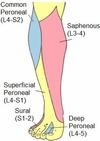S10) Nerve Injuries of the Lower Limb Flashcards
What are the consequences of nerve injuries?
- Loss of function (motor, sensory, proprioception)
- Neuroma formation (pain)
Have an understanding of the Seddon classification of nerve injuries:
What is neurapraxia (Class I nerve injury)?
Neurapraxia results in a temporary physiological block of conduction in the affected axons without loss of axonal continuity (mildest form)

Describe the features observed in a Class I nerve injury
- The endoneurium, perineurium and epineurium are intact
- No Wallerian degeneration
- Conduction is intact in the distal & proximal segments of the nerve (not in area of injury)
- Sensory and motor dysfunction distal to the site of injury

Describe the recovery period from a Class I nerve injury
Full recovery of the nerve conduction will occur over a period of days to weeks
Have an understanding of the Seddon classification of nerve injuries:
What is axonotmesis (Class II nerve injury)?
Axonotmesis involves the loss of continuity of the axons and their myelin sheath, but axonal regeneration is possible without surgical intervention

Describe the features observed in a Class II nerve injury
- Endoneurium, perineurium and epineurium are preserved
- Wallerian degeneration occurs (3-4 days distal to the site of injury)

Describe the recovery period from a Class II nerve injury?
- Axonal regeneration proceeds at a rate of 1-4 mm/day
- Time to recovery depends on the distance from the site of injury to the target organ
Have an understanding of the Seddon classification of nerve injuries:
What is a neurotmesis (Class III nerve injury)?
Neurotmesis is the most serious form of nerve injury occuring when both the nerve and the nerve sheath are damaged

Describe the features observed in a Class III nerve injury
- Endoneurium, perineurium, epineurium and axon are partially/completely divided
- Wallerian degeneration occurs (3-4 days distal to site of injury)
- Sensory, motor and autonomic defects are severe
Describe the recovery period from a Class III nerve Injury
Surgical intervention is always necessary as even in an incomplete divsion, deposition of scar tissue between fascicles precludes regeneration
Describe the nerve supply to the lower limbs
- Femoral nerve & branches
- Sciatic nerve & branches
- Obturator nerve
- Superior & inferior gluteal nerve
What are the causes of neuropathy?
- Injury-stretch of nerve
- Extrinsic pressures e.g. tumour, abscess, etc
- Medical conditions e.g. Diabetes, alcohol excess, drugs
What is Piriformis Syndrome?
Piriformis syndrome is a condition wherein the sciatic nerve becomes compressed / irritated by the piriformis muscle causing pain, paraesthesia and numbness in the hip/buttocks and along the path of the sciatic nerve
What is Meralgia paraesthetica?
- Meralgia paresthetica is a condition characterized by paraesthesia, numbness and burning pain in the outer part of your thigh
- It is due to the compression of the lateral cutaneous nerve of the thigh as it passes through the inguinal ligament / as it pierces the fascia lata
Identify some causes of Meralgia paraesthetica
- Obesity (compression by abdominal fat)
- Pregnancy
- Tight clothing
- Wearing a tool belt
What are the aggravating and relieving factors of meralgia paraesthetica?
- Aggravated by walking or standing
- Relieved by lying down with the hip flexed
How does Meralgia paraesthetic present on examination>
- Tenderness on palpation
- Reduced sensation
- Positive Tinel’s sign
How can Meralgia paraesthetica be managed?
- Avoid corsets and tight belts
- Local nerve blocks
- Surgical interventions (free the nerve)
How does a femoral nerve injury present?
- Muscle weakness on knee extension (quadriceps femoris), hip flexion (iliacus) and adduction (sartorius, pectineus)
- Sensory loss on saphenous nerve and medial cutaneous nerve of the thigh

How does a tibial nerve injury present?
- Muscle weakness on plantarflexion and inversion
- Unopposed pull of dorsiflexors and everters (calcaneovalgus posture)
- Loss of plantar sensation (except medial and lateral sides)

How does a common peroneal nerve injury present?
- Loss of ankle eversion and dorsiflexion
- Loss of sensation on lateral calf and dorsum of foot

How does a superficial peroneal nerve injury present?
- Weakness in ankle eversion
- Sensory loss over dorsum of foot (sparing 1st web space) and anterolateral calf

What are the causes of injury to the superficial peroneal nerve?
- Ankle surgery via a lateral approach
- Ankle arthroscopy portal placement
How does a deep peroneal nerve injury present?
- Muscle weakness in ankle dorsiflexion (foot drop)
- Sensory loss in the 1st web space





